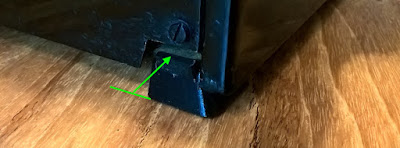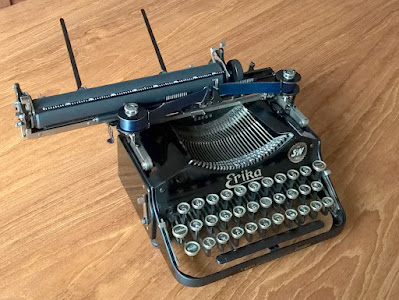To give the slots in the segment and the typebars themselves a thorough cleaning, the segment was removed from the machine. There was only so much that could be cleaned when still in the machine, the slots were fairly gummed-up.
Very unlike the tricky carriage assembly, taking out the segment of an Erika M typewriter is surprisingly straightforward. The segment block and also the type-guide are doweled, so they can be taken off and re-mounted without losing their adjustment. After removing the mounting screws the parts can be pried off, taking care with the dowel-pins. At both ends of the segment-block, a screw with a little plate holds the pivot-rod in place.
By the way; on the outer typebar can be seen some 'dimples' - this is likely where the typebar was peened for some final adjusting after soldering in new type-slugs. This was probably done as the machine was customised with added Æ and Å characters when purchased new.
Removing these little plates allows the pivot-rod to be pushed out. The typebars then can be slid out of their (gummy) slots. The segment-block is then completely free to be taken off for a proper cleaning. The typewriter does look a little dejected then...
The typebars cannot easily be taken off the machine, because the linkages have been riveted. A benefit of this is that the typebars cannot get out of order - the typebars are not numbered. (The number '1' that can be seen on the right-most Å typebar seems to indicate the type of bend it has, there are three '1' typebars, then three '2', followed by all '3' bars to the centre of the basket.)
The segment-block was thoroughly cleaned with white spirit (petrol sans additives) and polished-up. Working a rag and then cardboard strips through the slots helped to remove all the hardened dirt. The typebars were also polished-up (Brasso) with stubborn dirt first scraped off (wooden skewer). After this, both the segment and the typebars are smooth and clean again.
Then the segment can be re-fitted. Simply start inserting the typebars at one end and passing the pivot-rod through one typebar at a time. When they're all in, then the segment can be pushed onto its mounting-bar and fastened.
Clean, smooth typing-action again :-)

























